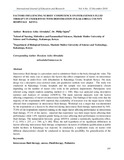FACTORS INFLUENCING NURSES' COMPETENCE ON INTRAVENOUS FLUID THERAPY IN UNDER-FIVES WITH DEHYDRATION IN KAKAMEGA COUNTY HOSPITALS KENYA
Abstract
Intravenous fluid therapy is a procedure used to administer fluids to the body through the veins. The
objective of this study was to analyze the factors that affect competence of nurses on intravenous
fluid therapy in under-fives with dehydration in Kakamega County hospitals Kenya. The study
design was a descriptive cross-sectional study and quantitative methods were adopted. . The study was
conducted in Kakamega County hospitals and the sample size was proportionately chosen
depending on the number of nurses who work in the pediatric departments. Participants were
selected using simple random sampling method (n = 198). Data was analyzed using descriptive
statistics and Analysis of variance (ANOVA). The main outcome measures were the factors
affecting competency of nurses on intravenous fluid therapy. The findings of the study were that the
majority of the respondents 84% reported that availability of resources was the major factor which
affected their competence in intravenous fluid therapy. Workload was a major that was mentioned
by the respondents as a factor to be observed during intravenous fluid therapy represented by 54%.
75.8% of the respondents reported training as the major factor affecting performance in intravenous
fluid therapy, 57.1% of the nurses reported that experience was their major factor affecting their
performance while 1.0% reported gender being an issue affecting their performance on intravenous
fluid therapy. The independent between- group ANOVA yielded a statistically significantly effect,
F (2, 197) = .237, p = .789, ƞp
2
= .002. Thus, the null hypothesis of no significant differences in
factors affecting intravenous fluid therapy competences in nurses of different qualification at public
health facilities in Kakamega was rejected. In conclusion, a replication study on nurses with
different characteristics should be conducted to increase the possibility for generalization of the
factors.
Collections
- Journal Articles [411]

